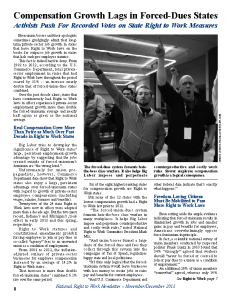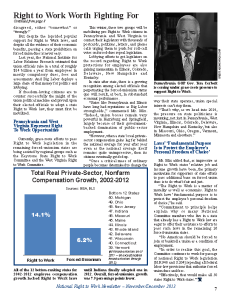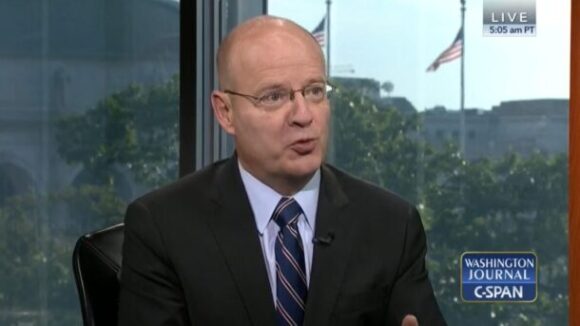Will Team Biden Weaponize Workers’ Pensions?
Big Labor abuse of worker pension and benefit funds as a means of advancing union bosses’ self-aggrandizing policy objectives is a familiar phenomenon.
(Click here to download the National Right to Work Committee’s November-December 2013 Newsletter)
Even union bosses and their apologists sometimes grudgingly admit that long-term private-sector job growth in states that have Right to Work laws on the books far outpaces job growth in states that lack such pro-employee statutes.
This fact is indeed hard to deny. From 1992 to 2012, according to the U.S. Commerce Department, total private-sector employment in states that had Right to Work laws throughout the period soared by 51% — an increase nearly double that of forced-union-dues states combined.
Over the past decade alone, states that have continuously had Right to Work laws in effect experienced private-sector employment growth more than double the forced-unionism average and nearly half again as great as the national average.
Real Compensation Grew More Than Twice as Much Over Past Decade in Right to Work States 
Big Labor tries to downplay the significance of Right to Work states’ large, persistent employment-growth advantage by suggesting that the jobs created outside of forced unionism’s dominion are “the wrong kind.”
Unfortunately for union pro-pagandists, however, Commerce Department data show that Right to Work states also enjoy a large, persistent advantage over forced-unionism states with regard to growth of private-sector employee compensation (including wages, salaries, bonuses and benefits).
Twenty-two of the 24 state Right to Work laws now in effect were adopted more than a decade ago. But the two most recent, Indiana’s and Michigan’s, took effect in early 2012 and this spring, respectively.
Right to Work statutes and constitutional amendments prohibit forcing employees to join or pay dues or so-called “agency” fees to an unwanted union as a condition of employment.
From 2002 to 2012, the inflation-adjusted outlays of private-sector businesses for employee compensation increased by an average of 14.2% in Right to Work states.
That increase is more than double forced-unionism states’ combined 6.1% rise over the same period.
Six of the eight highest-ranking states for compensation growth are Right to Work states.
But none of the 12 states with the lowest compensation growth had a Right to Work law prior to 2012.
“The forced-union-dues system foments hate-the-boss class warfare in many workplaces. It helps Big Labor impose and perpetuate counterproductive and costly work rules,” noted National Right to Work Committee President Mark Mix.
“And union bosses funnel a large share of the forced dues and fees they collect through this system into the campaigns of Tax & Spend, regulation-happy state and local politicians.
“It’s thus only logical that the forced-unionism system would leave businesses with less money to create jobs or raise pay and benefits for current employees.
“And U.S. Commerce Department and other federal data indicate that’s exactly what happens.”
 Freedom-Loving Citizens Must Be Mobilized to Pass More Right to Work Laws
Freedom-Loving Citizens Must Be Mobilized to Pass More Right to Work Laws
Even setting aside the ample evidence indicating that forced unionism results in diminished growth in jobs and smaller gains in pay and benefits for employees, Americans overwhelmingly oppose forced unionism in principle.
In fact, a scientific national survey of union members conducted by respected pollster Frank Luntz in 2010 found that 54% “strongly” agreed that workers should “never be forced or coerced to join or pay dues to a union as a condition of employment.”
An additional 26% of union members “somewhat” agreed, whereas only 14% disagreed, either “somewhat” or “strongly.”
But despite the lopsided popular support for Right to Work laws, and despite all the evidence of their economic benefits, passing a state prohibition on forced union dues is never easy.
Last year, the National Institute for Labor Relations Research estimated that union officials rake in a total of roughly $14 billion a year from employees in mostly compulsory dues, fees and assessments. And Big Labor deploys a large share of that money for politics and lobbying.
If freedom-loving citizens are to counter successfully the might of the union political machine and prevail upon their elected officials to adopt a state Right to Work law, they must first be mobilized.
Pennsylvania and West Virginia Represent Right To Work Opportunities
Currently, grass-roots efforts to pass Right to Work legislation in the remaining forced-unionism states are being assisted by regional groups such as the Keystone State Right to Work Committee and the West Virginia Right to Work Committee.
This winter, these two groups will be mobilizing pro-Right to Work citizens in Pennsylvania and West Virginia to contact their legislators with thousands of postcards, petitions, letters, and phone calls urging them to push for roll-call votes on forced-dues repeal legislation.
Lobbying efforts to get legislators on the record regarding Right to Work protections for employees are also gaining momentum in Illinois, Colorado, Delaware, New Hampshire and Kentucky.
In state after state, there is a growing recognition among elected officials that perpetuating the forced-unionism status quo will result, at best, in substandard economic performance.
“States like Pennsylvania and Illinois have long had reputations as Big Labor strongholds,” commented Mr. Mix. “Indeed, union bosses remain very powerful in Harrisburg and Springfield, largely because of their government-backed domination of public-sector employment.
“However, when a state’s real private-sector compensation gains lag far behind the national average for year after year even as the national average itself remains quite unimpressive, then its citizens eventually get fed up.
“Once a critical mass of ordinary people becomes determined to change the way their state operates, union special interests can’t stop them.
“That’s why, as we head into 2014, the pressure on state politicians is mounting, not just in Pennsylvania, West Virginia, Illinois, Colorado, Delaware, New Hampshire and Kentucky, but also in Missouri, Ohio, Oregon, Vermont, Minnesota and elsewhere.”
Laws’ ‘Fundamental Purpose Is to Protect the Employee’s Personal Freedom of Choice’
Mr. Mix added that, as impressive as Right to Work states’ relative job and income growth have been, the primary motivation for supporters of state efforts to pass additional bans on forced union dues is to do what’s fair and just.
“The Right to Work is a matter of morality as well as economics. Right to Work laws’ fundamental purpose is to protect the employee’s personal freedom of choice,” he said.
“Commitment to principle helps explain why so many National Committee members who live in a state that already has a Right to Work law are eager to offer their assistance to efforts to pass such laws in the remaining 26 forced-unionism states.
“No American should be forced to join or bankroll a union as a condition of employment.
“In order to realize this goal, the Committee continues to work for passage of national Right to Work legislation [H.R.946 and S.204] repealing all federal labor-law provisions that authorize forced union dues and fees.
“Effectively, that would make all 50 states Right to Work states.”

Big Labor abuse of worker pension and benefit funds as a means of advancing union bosses’ self-aggrandizing policy objectives is a familiar phenomenon.

What impact does handing a union monopoly power to deal with your employer on matters concerning your pay, benefits, and work rules have on your pay?

Security guard James Reamsma is disappointed that the Right to Work repeal re-imposes forced-dues payments, but he and his coworkers still have a shot to restore their liberty.